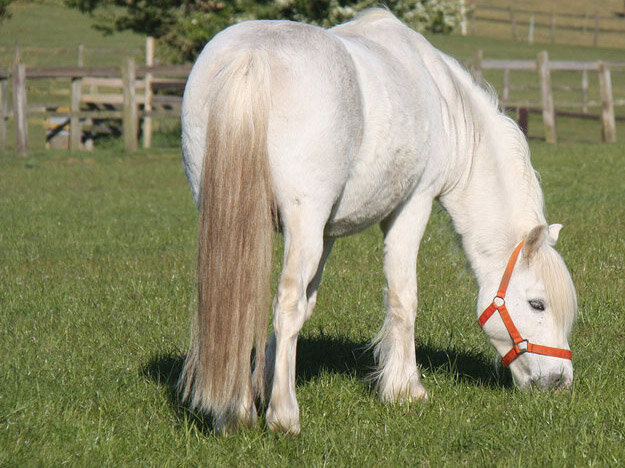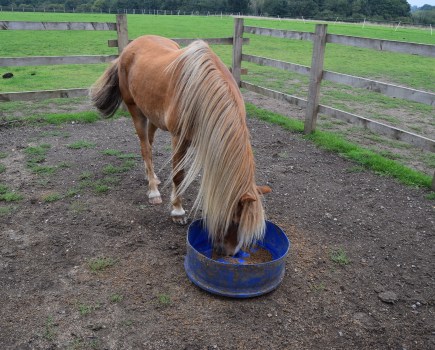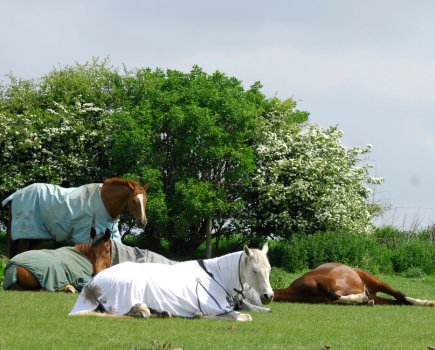Equine obesity, insulin resistance and laminitis are all directly linked in horses and ponies. Each condition can have a huge negative impact on horse health, yet are avoidable with correct management.
Insulin is a hormone that helps to regulate glucose levels in the body. In a healthy horse, insulin being released would cause glucose to be absorbed from the bloodstream into cells within the body where it is used for energy.
In a horse with insulin resistance, insulin is still released, but the body is less sensitive to it, meaning that a high proportion of the glucose stays in the bloodstream as opposed to being absorbed by the cells.
“Because the insulin hasn’t had the desired effect, more insulin is then produced and released into the bloodstream,” explains registered veterinary nurse Libby Smith, who is a member of the British Equine Veterinary Association (BEVA).
“This is dangerous because high levels of insulin in a horse’s blood can be a direct trigger for laminitis.”
Dangers of insulin resistance
Research has found that fat tissue (adipose tissue) can actually develop the ability to secrete hormones.
Hormones are chemical messengers within the body, and the hormones produced by adipose tissue can affect immune function, inflammation, tumour development and, most importantly here, glucose regulation.
“Insulin facilitates the removal of glucose from the blood, so insulin resistance results in blood sugar levels remaining high, despite more and more insulin being produced,” says Libby.
“Our modern-day understanding is that this overexposure to insulin and glucose damages the cells lining the blood vessels. As these cells are responsible for the constriction and dilation of blood vessels, the link between obesity, insulin resistance, and laminitis starts to become apparent.”
Supporting the pedal bone
The hoof wall is made of an interlinked outer sensitive layer (horn), supported by an underlying inner sensitive layer (laminae).
In laminitis, the blood flow to the laminae is affected, resulting in inflammation and swelling in the tissues within the hoof and severe pain. As the laminae are starved of oxygen and nutrient-rich blood, the cells become damaged.
The laminae are responsible for supporting the pedal bone in the hoof and therefore the weight of the animal. In severe cases of laminitis, the pedal bone can sink and rotate due to the inability of the damaged laminae to offer support.
“This is another reason to avoid your horse becoming overweight, as mechanically it is harder for the laminae to offer the pedal bone support if it is being asked to carry more weight than its original design intended,” states Libby.
Managing obesity
While a combination of diligent clinical care, medication, remedial farriery and diet can resolve some cases of laminitis, this is not a given. Sadly, in some instances, euthanasia may turn out to be the kindest option.
“Some owners are reluctant to put their horse on a diet because they see limiting their feed as a reduction in quality of life,” says Libby.
“However, it has to be remembered that their quality of life will definitely plummet if they end up with laminitis. In this scenario, their pain needs to be managed and often requires prolonged periods of box rest — all with no guarantee of a successful outcome.
“The veterinary treatment and remedial farriery involved in these cases is also expensive compared to the cost of putting your horse on a diet, which will, of course, save you money on feed bills,” adds Libby.
Nature’s way
Insulin resistance is a naturally occurring trait in many horses and ponies native to Britain, such as Dartmoors, Welsh cobs and the Suffolk Punch.
Historically, it would have put these breeds at an evolutionary advantage. In the summer when food was plentiful, these equines would have become overweight, leading to some degree of insulin resistance.
“This would have been advantageous to these animals, because insulin resistance directs the body to store excess energy as fat, meaning that they would enter the winter with fat deposits to use as a reserve when food became scarce,” explains Libby.
“These horses and ponies would then leave winter and enter spring looking thin and being clinically normal once more, ready for the cycle to repeat itself when food became more plentiful again.”
Modern management of equines, including regular high-calorie feeds, warm rugs and cosy shelter all year round, means that many horses and ponies never use up their fat reserves in the winter.
Instead, they continue to maintain condition before gaining more weight in the summer when the grass quality improves. This is where the problem lies.
New research into insulin dysregulation
A study from the Royal Veterinary College (RVC) in September 2023 determined new factors that can indicate insulin dysregulation in ponies. The study findings confirm that physical observation alone is not a wholly accurate predictor of the condition.
The research, conducted in association with the Waltham Equine Studies Group and Spillers, found that insulin dysregulation may occur in equines across a wide range of body conditions, ages and levels of exercise, not just in those that are overweight.
In addition, the study demonstrated that insulin dysregulation was less common in ponies that undertook more exercise including low-intensity exercise.
These findings will impact the variables considered by equine health professionals when targeting ponies for insulin dysregulation screening, helping to ensure that early indicators of increased risk of laminitis are not missed.
The impact of low-level exercise
The impact of even low-level exercise, as identified in the study on reducing occurrence of insulin dysregulation, is also an important consideration for horse owners as exercise can be modified.
“Our work has shown that while physical and owner-reported features can be used to identify ponies with a higher risk of insulin dysregulation, veterinarians should not limit testing for insulin dysregulation to ponies in which these risk factors are present,” said Edd Knowles, lead author on the paper.
“Doing so would miss identifying ponies at moderate to high risk of laminitis.









